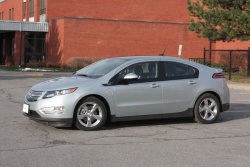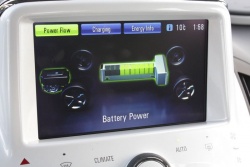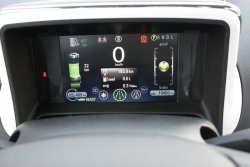Acceleration (from the 149-hp electric motor) is good. The Volt can motor (so to speak) from 0-100 km/h in 9.0 seconds, but it’s heavy at 1,714 kilograms (3,791 lbs), and feels it. In comparison, a conventionally powered Chevrolet Malibu, for instance, is 1,551 kg (3,418 lbs), and a Ford Fusion automatic is 1,515 kg (3,342 lbs).
  2012 Chevrolet Volt. Click image to enlarge |
In preparation for this trip, we charged the Volt overnight using the standard 110V charge cord. With no rain forecast, we used an outside outlet, but protected the charge cord just in case.
In the morning, with a full charge, we were somewhat surprised to see that its range as an EV was only 46 km. The Volt’s electric-only range is advertised as 40-80 km, and presumably the 46 km number was based on the driving history of this particular car, which had 10,400 km on the odometer.
However, 46.9 km is what we achieved before the Volt switched to gasoline, and after that, it operated similarly to a conventional hybrid, with the car’s regenerative braking charging the battery, which assisted the gasoline engine. A power flow graphic shows you this process in action, but remember, the gasoline engine never directly powers the wheels.
In extended range mode, the Volt is not as quiet. The 1.4-litre, four-cylinder engine emits a mild hum in the background, and on occasion whirrs audibly as it works to generate electricity for the battery. It’s not objectionable, but seems a little incongruous. operation isn’t linear like it is in a conventional car, where the engine note rises and falls in time with the car’s speed. Therefore, the gas powerplant might “idle” high when the car is stopped, and then purr along nearly imperceptibly when the car is at speed.
Our speed on a combination of secondary and multi-lane highways ranged between 90-115 km/h, and en route we found the driver’s seat very comfortable and supportive, and were impressed with the design of the interior and its fit and finish.
Speed is not the order of the day either. The Volt is about as quick in a straight line as a typical subcompact car; 149 horsepower (from the electric motor) and a curb weight of more than 1,700 kg (3,781 lbs) will do that. What makes it feel quicker than it is, at least at first, is lack of noise. When running on electricity, hard acceleration from a stop generates some quiet whirring and whining noises; the only familiar sound is the tire noise that ramps up as the car gains speed. One thing that takes getting used to, and that we hadn’t expected, is the lack of a racing engine note to indicate that the front wheels are spinning in slippery conditions.
 2012 Chevrolet Volt. Click image to enlarge |
Once back in Ottawa, we ran the battery down on two occasions; both times, we travelled a little more than 40 kilometres before it went flat and the engine had to start. Even with the engine as a backup, driving this car makes you acutely aware of how far you travel; it becomes a bit of a game to see how much distance you can cover on a full charge. In city driving, according to the Volt’s trip computer, we burned a total of 0.6 litres of gasoline, for a fuel consumption average of 0.32 L/100 km. Our actual energy consumption rate was higher than that, of course, but we figure our four days of driving cost about $5 in gasoline and electricity costs. On our highway trip, the vehicle returned 5.5 L/100 km, after 460 highway kilometres, and including the 46.9 km from the battery. A fill-up cost $26.00.











